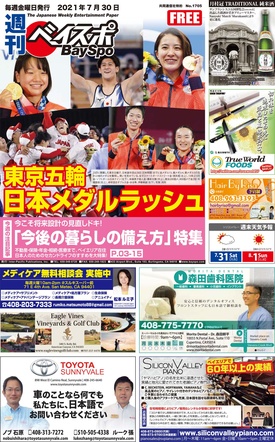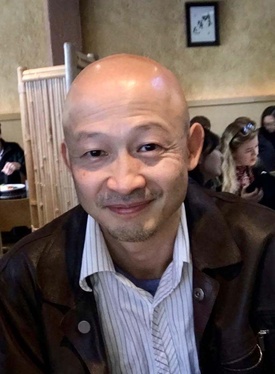A pioneer of free SF media
Recently, I often check out the Facebook community "Japanese in America." A common post I see in this community is, "I'm moving to the XX area. Can you recommend some local Japanese information magazines?" As a Southern California resident, I can immediately write a recommendation for a publication in Los Angeles, but to be honest, I'm not familiar with the Japanese media situation in the Bay Area, which is also in California. So, although I'm looking at it from a one-sided perspective, one publication that local residents recommend as a Japanese media outlet in the Bay Area is Weekly Bayspo. I spoke to publisher Satoaki Ono about it.
"Weekly Bay Sports was first published in 1999. We distribute 20,000 copies every week in the Bay Area, including San Francisco and Silicon Valley. Our readers are men and women of all ages and from all over the world. It is said that there are between 50,000 and 60,000 Japanese people living in this area."
Onozato recalls that the impetus for starting the magazine came when he "came across the Nikkan Sun when he was commuting to Los Angeles to watch Hideo Nomo's games." The Nikkan Sun is a Japanese-language newspaper published in Los Angeles that covers mainly sports and entertainment. "Back in 1995, I used to look forward to reading that newspaper every time I came to Los Angeles. I always wanted a newspaper like that in San Francisco. So I became the publisher myself, made it a weekly paper instead of a daily one, and created a weekly paper that covers sports, entertainment, and local topics."
Until then, the Bay Area had been dominated by paid media. "In Los Angeles, there were free papers like The Lighthouse, Bridge USA, and The Nikkan Sun, but in San Francisco, the only papers people read were paid papers like The Asahi Shimbun, North American Mainichi, and Nichibei Jiji. The secret to our survival? We partnered with Japanese sports newspapers to obtain information on Japanese sports and entertainment, and purchased current affairs from news agencies. This allowed us to reduce costs (such as labor costs) while publishing the latest information from Japan. We met the needs of readers who wanted to read about Japan, and as I said earlier, the fact that there were no other free Japanese papers was also a factor in our success."
After that, as Japanese sports and entertainment information became available via the Internet, Weekly Bayspo's content began to change. More space was devoted to local lifestyle information. "We now cover a wide range of lifestyle information, from restaurant information to classifieds. The topics that readers are most interested in now are local topics such as commercial development and crime. We believe that there is a demand for a casual, Japanese-language magazine that allows readers to read about what is happening in the Bay Area right now without feeling pressured."
Information is collected
As of 2021, Weekly Bayspo has established itself as a popular magazine in the Bay Area, but when asked about the struggles it faced along the way, Onozato replied: "We struggled during the first six months of publication. We were caught in a vicious cycle of not getting any picks even though it was free, and because we weren't getting any picks, it was hard to attract advertising. However, once people started picking it up, it became a habit for readers, and it's remained that way ever since. However, it was still difficult during the pandemic. Our advertisers' businesses were in a difficult situation, and we had no time for advertising. So our staff went to our clients' offices to see if there was anything we could do to help, and we tried to maintain relationships."
Onozato says it's important to keep publishing even in difficult times. "Because we've been doing this for a long time, information (about the Japanese community in the Bay Area) naturally comes to us. Also, Silicon Valley is home to the headquarters of Google and Apple, and it's a very business-heavy area. More and more people from Japan are moving here. Until COVID-19, the Japanese population was growing."
Furthermore, Onozato's company is a publishing company that publishes a yearly magazine called "e-jan," which compiles information on daily life in the Bay Area. When asked about his vision for the future, he said, "We're going to get serious about going online. Not only will the information in the paper be available on the website as an electronic version, but we also plan to expand the website's own content." He spoke of plans that will be exciting for readers outside the area.
Finally, Onozato mentioned an episode from 22 years ago when he was planning to start a magazine. "When I went to Los Angeles to watch Nomo's matches, I liked a shabu-shabu restaurant in Little Tokyo. So when I was in talks with a Japanese sports newspaper company to prepare for the launch of 'Weekly Bay Sports,' I didn't get a good response, so I gave up on publishing a newspaper and was thinking of opening a shabu-shabu restaurant in San Francisco. Just then, a sports newspaper company responded, so I gave up on the shabu-shabu restaurant. If I had gone for shabu-shabu at that time, I might have made more money as a business (laughs). But I think it was good to be in the media. It's a fun job where you can meet a lot of different people, and above all, you get a sense of being wanted by the local Japanese community." "I'm glad Onozato didn't go for the shabu-shabu business," I'm sure it's the readers in the Bay Area who think this more than Onozato himself.
Official website " Weekly Bayspo "
© 2021 Keiko Fukuda








